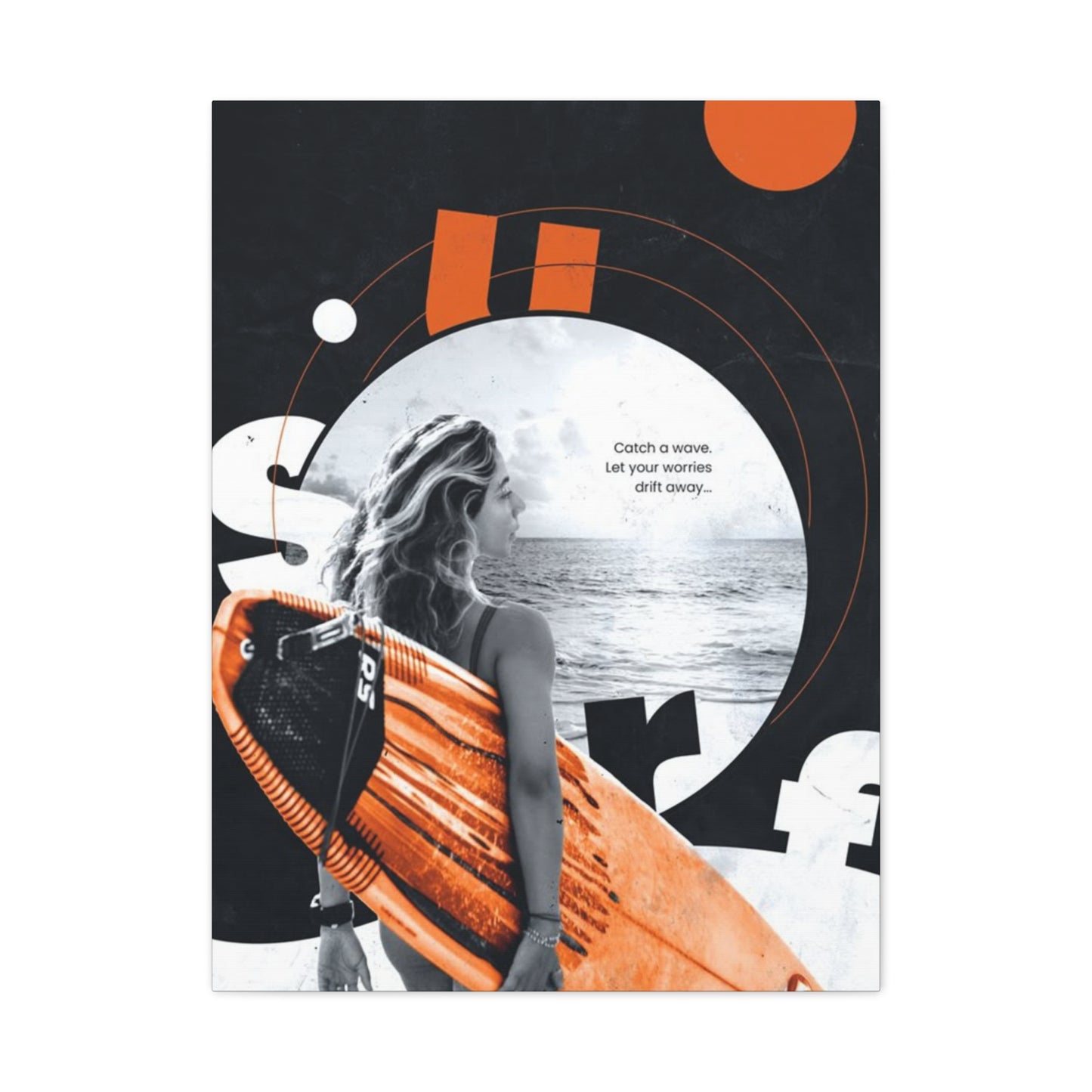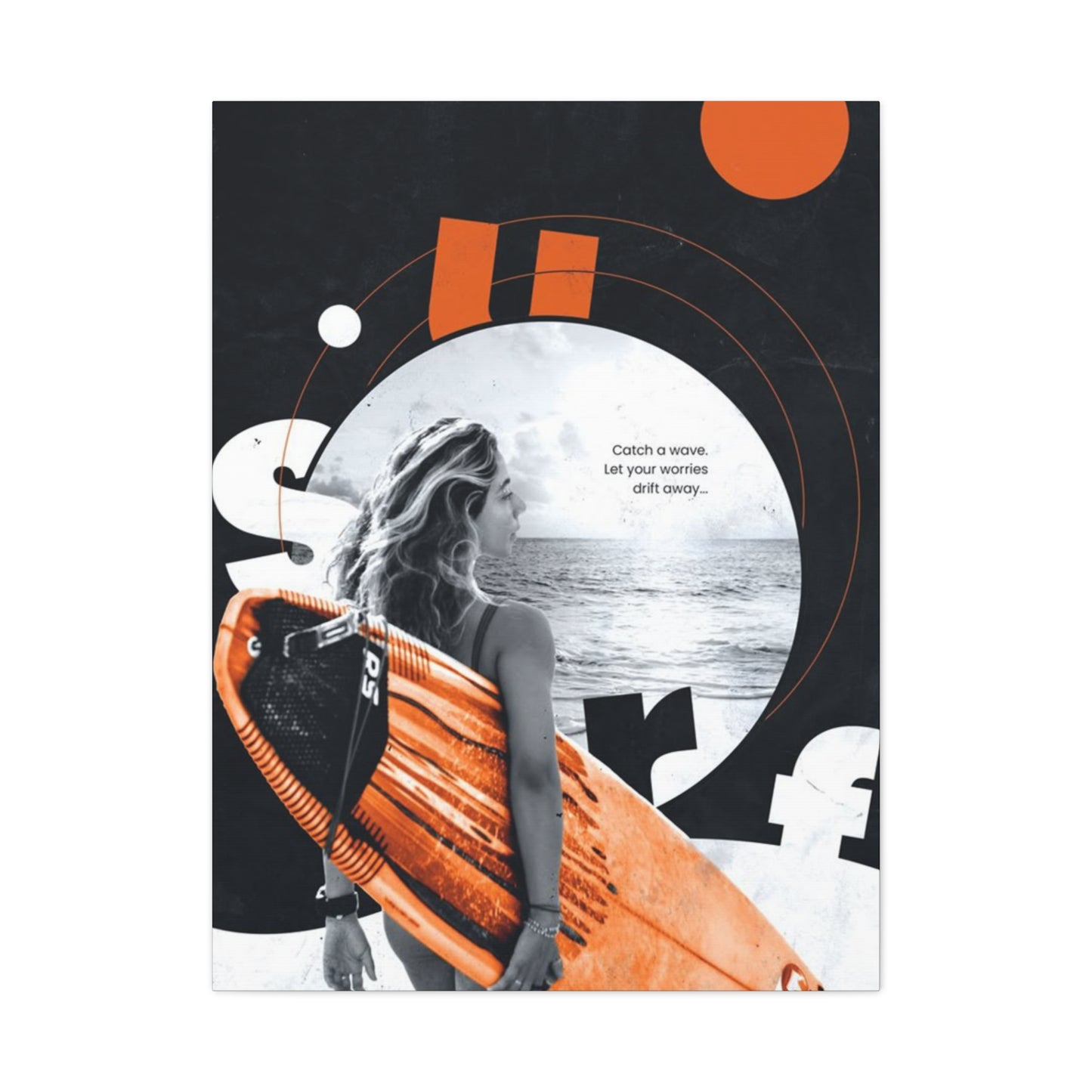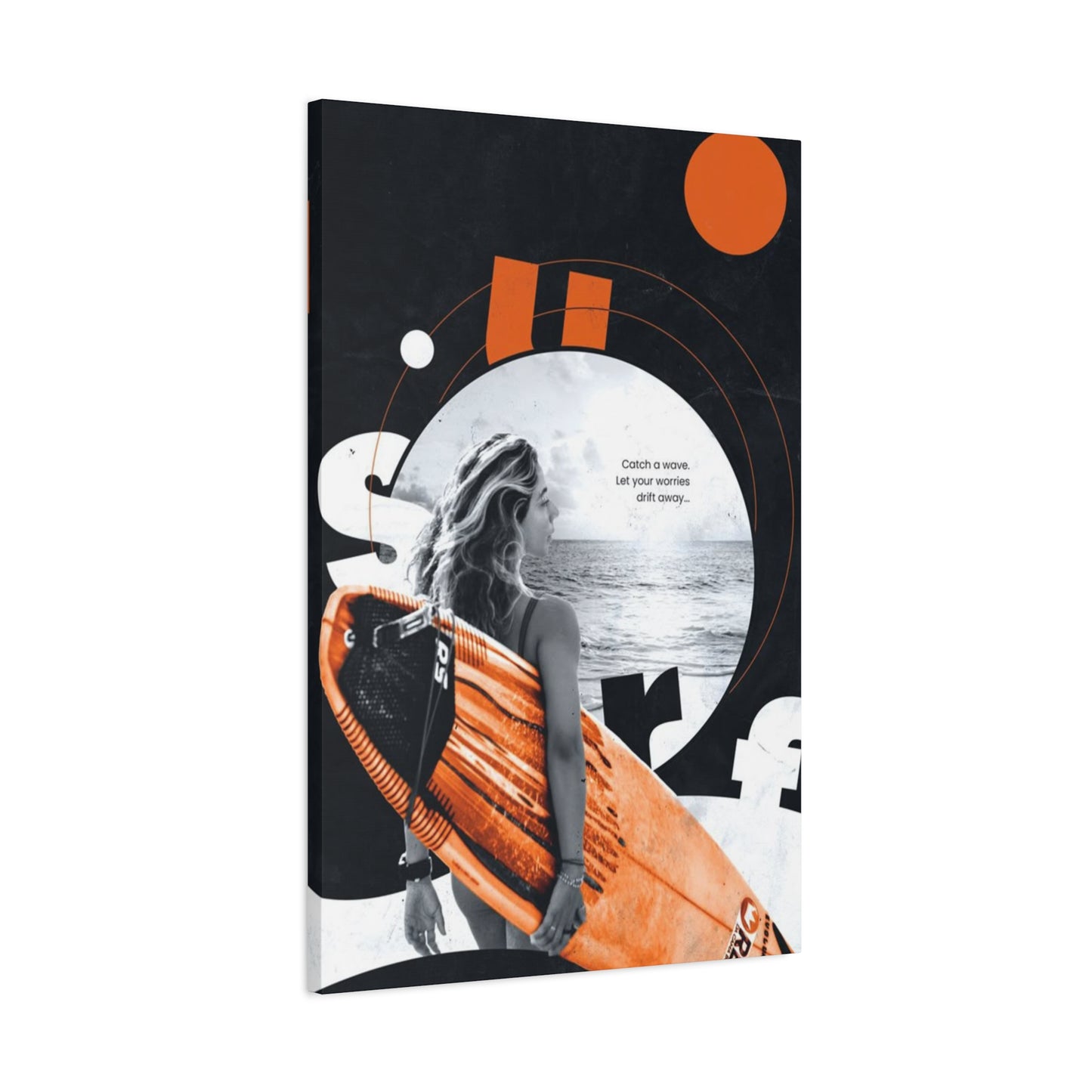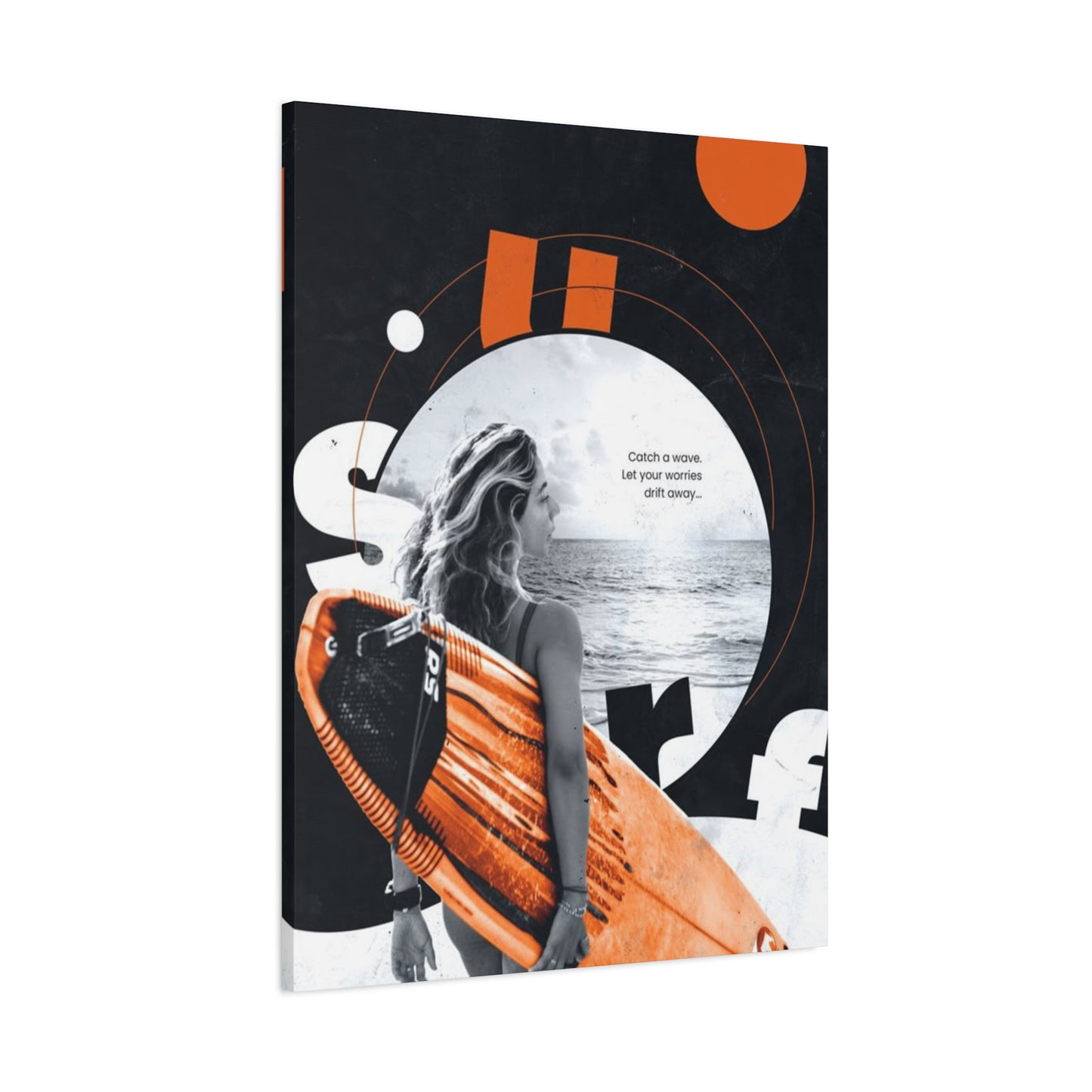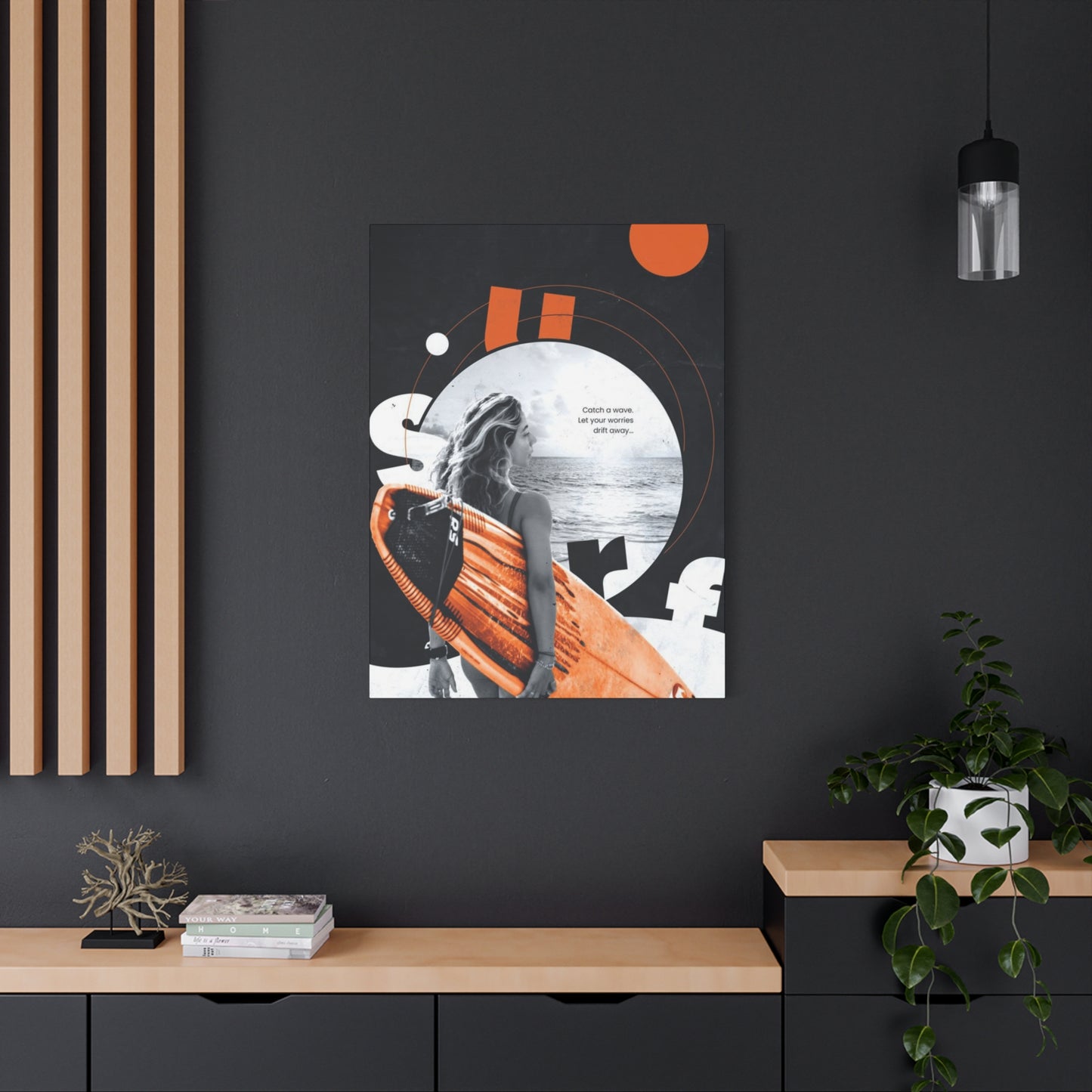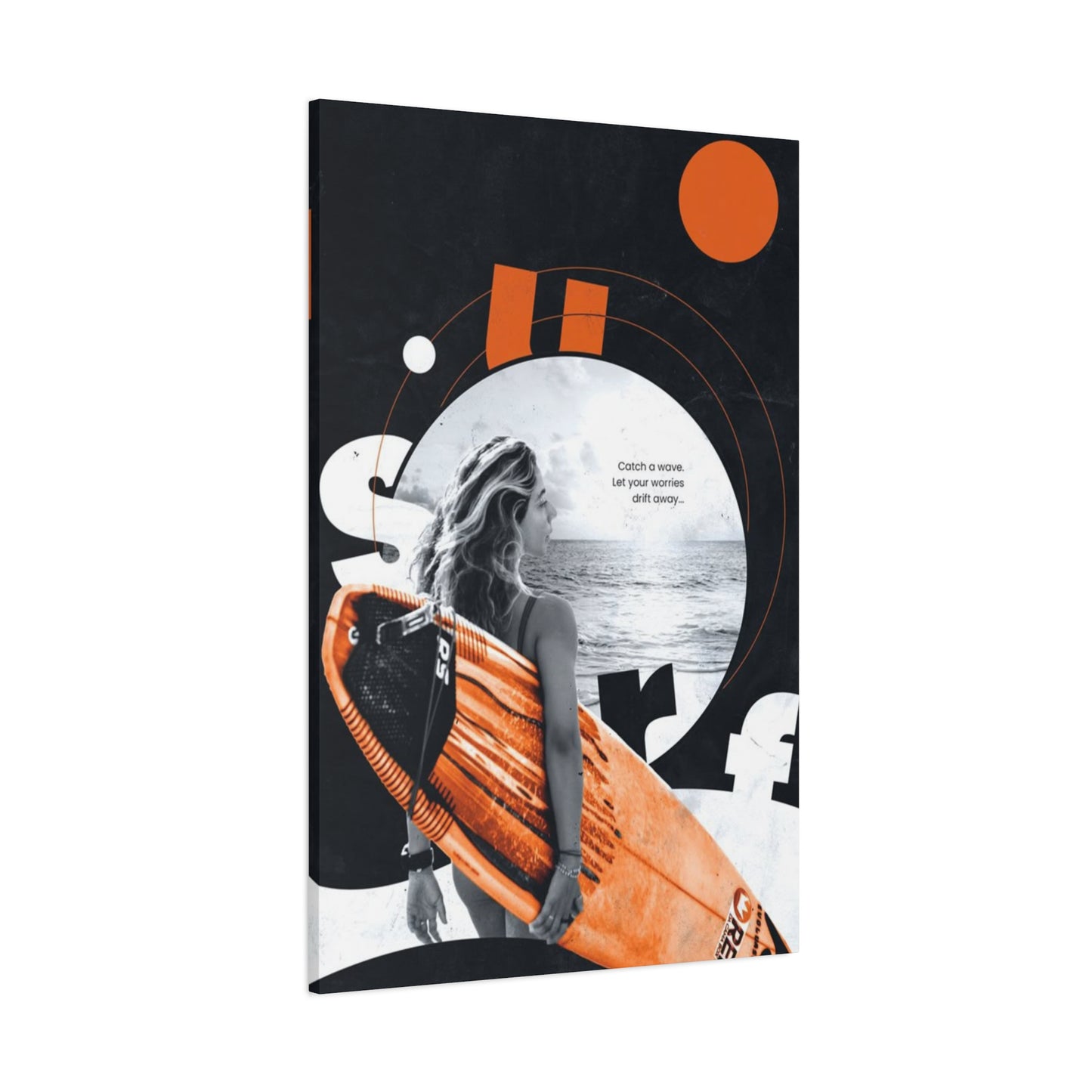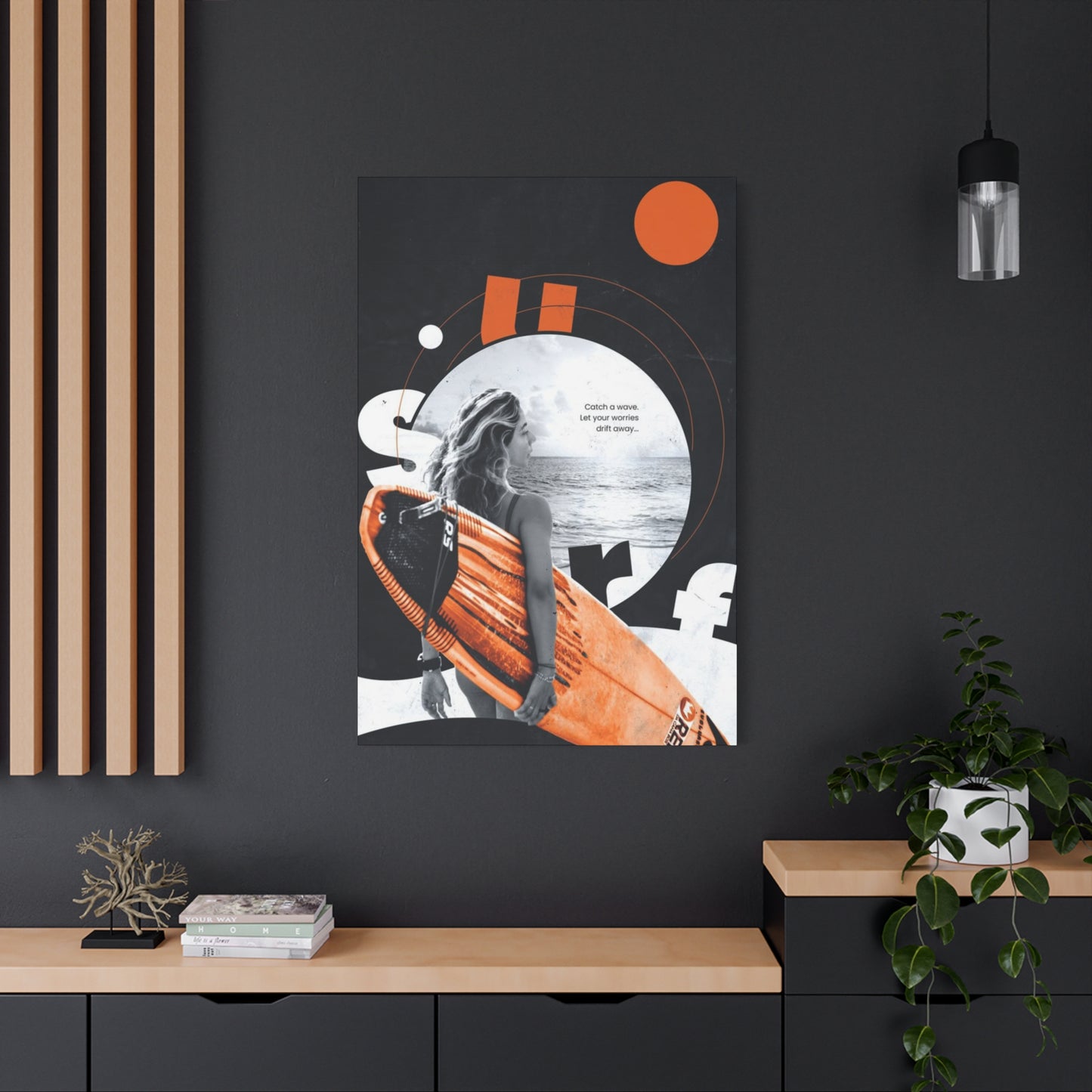Ride, Surf, Inspire: Professional Surfing Poster Wall Art for Dynamic Interiors
Surfing posters have become an essential element of contemporary interior design, particularly for those who embrace the coastal lifestyle and appreciate the raw beauty of ocean sports. These artistic pieces capture the essence of wave riding and the adventurous spirit of surfers who dedicate their lives to mastering the ocean. When you bring professional surfing wall art into your home, you are not simply hanging a picture on your wall. Instead, you are creating a window into a world of action, freedom, and natural beauty that resonates with people across all age groups and backgrounds. The appeal of these posters extends beyond mere aesthetics. They serve as constant reminders of the thrill that comes with pursuing passions and pushing personal boundaries.
Whether displayed in a bedroom, living room, or dedicated man cave, surfing wall prints create an atmosphere that inspires and energizes everyone who enters the space. The vibrant colors, dynamic compositions, and powerful imagery of professional surfers in motion transform ordinary walls into galleries of excitement and adventure. Many people who have never even surfed themselves find themselves drawn to the energy and beauty captured in these pieces. This universal appeal explains why surfing action posters have grown so popular across residential and commercial spaces alike.
The psychological connection to water environments plays a significant role in the widespread appreciation for surfing imagery. Human beings possess inherent affinities for water environments, a phenomenon researchers call biophilia. This natural attraction to aquatic settings means that imagery featuring waves, oceans, and water sports triggers deep emotional responses that transcend conscious decision-making. When surfing posters featuring dramatic ocean scenes enter your space, they activate these primal connections, creating feelings of peace, wonder, and connection to natural forces. This biophilic response explains why people gravitating toward professional surfing posters for beach vibes often report feeling more relaxed and content within decorated spaces.
The aspirational dimension of surfing culture enhances appeal substantially. For many viewers, surfers represent idealized versions of themselves, embodying courage, strength, and the freedom to pursue passions despite practical constraints. Displaying catch the perfect wave surfing wall art serves as daily visual affirmation of values and goals. Each glance at these pieces reinforces commitment to personal growth, adventure seeking, and maintaining connection with what matters most. This motivational function makes surfing action and adventure posters more than decoration, transforming them into tools for maintaining focus and inspiration throughout daily life.
The Evolution of Wave Riding Posters in Contemporary Art
The history of wave riding posters traces back several decades, evolving from simple promotional materials used by beach communities to sophisticated artistic expressions that command respect in fine art circles. In the early days, these prints were primarily found in surf shops and beach towns, serving as merchandise for tourists and local enthusiasts. As the sport gained mainstream recognition and the artistic quality improved dramatically, professional surfing in poster form began appearing in galleries and high-end retail establishments. The transformation of how artists approach surfing wall decor reflects broader changes in visual culture and design trends.
Early surfing posters from the nineteen sixties and seventies featured relatively simple designs, often using hand-drawn illustrations or basic photographic reproduction. These pieces captured the carefree spirit of that era, with emphasis on colorful, sometimes psychedelic imagery reflecting broader cultural movements of the time. The graphic design principles were straightforward, prioritizing bold colors and simplified compositions over detailed technical execution. Despite technical limitations, these vintage pieces now command significant collector interest and serve as nostalgic windows into surfing's historical development.
Modern surfer posters now feature cutting-edge photography techniques, digital artistry, and innovative printing methods that produce stunningly detailed images. The composition and color palettes have become more sophisticated, with artists carefully considering how each element contributes to the overall impact of the piece. What once might have been considered niche decoration has evolved into a legitimate art form that attracts collectors and design enthusiasts worldwide. The progression from basic surf lifestyle in bold posters to today's refined artistic interpretations demonstrates how ocean thrills captured in posters have matured alongside the broader art world.
Contemporary designers now blend traditional artistic principles with modern sensibilities, creating pieces that appeal to both longtime surfers and newcomers to the sport. This evolution reflects the changing demographics of those who appreciate surfing imagery. No longer limited to surfers themselves, audiences now include interior designers, art collectors, and anyone seeking to add vibrant energy to their living spaces. The artistic legitimacy that modern surfing action and adventure posters have achieved validates the medium as a serious form of creative expression worthy of investment and curation.
The influence of digital technology on poster creation cannot be overstated. Photography has evolved from film-based capture to sophisticated digital imaging that allows unprecedented control over composition, color correction, and final presentation. Digital artists now create impossible scenarios, blending multiple images and applying techniques impossible with traditional methods. The democratization of design tools means that emerging artists can create professional-quality work without access to expensive equipment or formal training. This accessibility has expanded the diversity of artistic voices contributing to the surfing poster landscape.
Exploring the Different Styles of Surf Culture Wall Prints
The variety of styles available in professional surfer posters for coastal homes demonstrates the diversity of artistic approaches to capturing the surfing experience. Some artists focus on photorealistic representations that showcase the incredible athletic ability and balance required to ride waves successfully. These catch surfing energy on posters through precise detail and authentic representation of surfers in their element. The technical mastery required to capture split-second moments of athletic perfection demands exceptional skill and patience from photographers positioning themselves to capture optimal angles, lighting, and composition.
Other creators take more abstract or stylized approaches, using bold lines, dramatic color contrasts, and creative compositions to convey the spirit of the sport rather than its literal appearance. Pop art inspired surfing mastery in poster prints represents another popular category, featuring bold colors, simplified forms, and a modern sensibility that appeals to younger audiences and those seeking contemporary aesthetics. The pop art movement's influence on surfing imagery brings the tradition of celebrated fine artists like Andy Warhol into conversation with surfing culture, elevating the sport's cultural status and artistic legitimacy.
Minimalist designs offer yet another option, stripping away unnecessary details to focus on essential elements that define wave riding. These carefully curated compositions prove that you do not need elaborate imagery to create compelling wall art. A simple silhouette of a surfer balanced on a wave against a monochromatic background can communicate the sport's essence more powerfully than complicated, busy imagery. The sophistication of minimalist design appeals particularly to those with modern sensibilities who appreciate restraint and elegant simplicity.
Vintage-style prints evoke nostalgia for classic surfing culture, drawing inspiration from the sport's golden age and the aesthetics of past decades. These pieces often incorporate design elements from nineteen sixties and seventies pop culture, creating retro vibes that appeal to those seeking period authenticity or nostalgic connection to surfing's cultural history. The warm color palettes, groovy typography, and relaxed compositions of vintage pieces create instantly recognizable aesthetics that transport viewers to specific historical moments.
Photography-based pieces capture real surfers in action, preserving moments of athletic excellence and natural beauty. Digital illustrations and paintings offer entirely new possibilities for artistic interpretation, allowing creators to explore imaginative scenarios and dreamlike representations of the surfing experience. Hyperrealistic digital art blurs boundaries between photography and illustration, creating technical virtuosity that astonishes viewers. Fantasy and surreal interpretations transport surfing imagery into impossible contexts, inviting creative engagement and imaginative contemplation.
Collage and mixed media approaches combine multiple artistic techniques and materials to create textured, layered compositions. These pieces often incorporate found materials, photographs, paint, and unconventional elements that create distinctive visual experiences. The dimensional quality of mixed media pieces adds depth and tactile interest beyond what flat imagery alone can achieve. Black and white photography strips away color distraction, focusing attention on composition, texture, and the essential drama of surfing action. The timeless quality of monochromatic imagery appeals to those seeking classic sophistication and artistic seriousness. Sepia-toned or color-tinted variations on black and white photography create vintage aesthetics that bridge contemporary and historical periods.
Watercolor and ink illustrations bring painterly sensibilities to surfing imagery, creating soft, flowing compositions that emphasize artistic interpretation over documentary accuracy. The spontaneity and organic quality of these techniques create pieces that feel personal and emotionally expressive. Pen and ink drawings create bold, graphic interpretations that emphasize line and composition over color. The inherent contrast between black ink and white paper creates dramatic visual impact, while the linear nature of drawing emphasizes movement and flow.
Each style serves different preferences and interior design schemes, ensuring that there is truly something for everyone seeking to enhance their space with professional surfing wall decor. Personal preference ultimately determines which styles resonate most strongly, though exposure to diverse artistic approaches often expands appreciation and reveals unexpected attractions to unfamiliar styles.
The Impact of Dynamic Surfing Action on Posters in Home Design
Incorporating bold surfing moments captured in posters into your home design creates an immediate visual impact that transforms the entire character of a space. These pieces serve as focal points that draw the eye and set the tone for the surrounding aesthetic. When strategically placed, dynamic surfing action on posters can anchor a room's design scheme, with other furniture and decor choices complementing the colors and energy of the artwork. The psychological effect of surrounding yourself with energetic imagery should not be underestimated.
Bold and beautiful surf posters inspire creativity, boost mood, and create an environment that feels alive and engaging. Many people find that these pieces motivate them to pursue their own passions and take on new challenges. The presence of epic wave posters for surf enthusiasts in a home communicates something about the residents' values and interests. It suggests a connection to nature, an appreciation for athleticism, and a desire to maintain the excitement and freedom of the ocean lifestyle even when far from the beach. This personal expression through decor choices reflects broader trends in how we curate our living environments to tell our stories and celebrate our identities.
The versatility of professional surfing posters for beach vibes means they can be integrated into various design themes. Contemporary minimalist spaces can feature large-scale black and white wave riding posters paired with clean lines and neutral tones. The simplicity of minimal design allows the powerful imagery to command attention without competing elements. Bohemian interiors embrace vibrant, colorful surfing action wall art that complements eclectic furnishings. The free-spirited nature of boho aesthetics aligns perfectly with surfing culture's emphasis on freedom and individual expression.
Even modern industrial spaces can incorporate these pieces, creating striking contrasts between raw materials and energetic imagery. Exposed brick, concrete, and metal elements provide neutral backdrops that allow colorful surfing posters to stand out. The juxtaposition of rough industrial materials with dynamic ocean imagery creates visual tension that enhances visual interest. Farmhouse and rustic design schemes can incorporate surfing wall decor by selecting pieces with warm color palettes and weathered frame styles. The connection between rural simplicity and beachside relaxation appeals to those seeking peaceful, grounded environments. Art deco and retro design movements provide rich contexts for vintage-inspired surfing posters that echo past decades' design sensibilities.
The ability of celebrate the surfing spirit with posters across multiple design approaches demonstrates their universal appeal and versatility. Strategic color coordination ensures that selected pieces harmonize with existing interior elements while introducing fresh visual interest. Neutral spaces benefit from vibrant surfing action and adventure posters that provide color and energy. Highly colorful environments work better with more subdued, neutral-toned pieces that avoid overwhelming visual competition.
Choosing the Right Sizing and Placement for Surfing Wall Art
The success of featuring celebrate surfing with wall prints in your home depends significantly on proper sizing and strategic placement. A common mistake involves purchasing artwork that is either too small for the wall space or oversized in ways that create visual imbalance. The general rule suggests that artwork should occupy approximately sixty to seventy-five percent of the wall space above furniture. This provides visual interest without overwhelming the space or creating a cluttered appearance. Undersized pieces on large walls appear lonely and insignificant, failing to create intended visual impact. Oversized pieces in small spaces create oppressive feelings and visual discomfort.
When selecting the dimensions for your professional surfing posters for beach vibes, consider the scale of the room and the surrounding furniture. Large open walls in spacious areas can accommodate substantial pieces that make bold statements. Smaller rooms or tighter spaces benefit from medium-sized prints that maintain proportion and visual balance. Multiple smaller pieces can be arranged in gallery-style configurations to create impact without requiring excessive wall space. The relationship between piece size and room dimensions determines whether artwork feels appropriately scaled and visually integrated.
The height at which you mount your surfer's grace and power on posters matters tremendously for visual comfort and engagement. Ideally, the center of the artwork should be positioned at eye level when standing, approximately fifty-eight to sixty inches from the floor. This positioning ensures that viewers naturally engage with the piece without experiencing neck strain or awkward viewing angles. Below eye level placement makes pieces feel subordinate to furniture or flooring. Above eye level placement creates discomfort when trying to view pieces comfortably.
Above sofas, wall art should be positioned with sufficient space between the furniture and the piece to create visual separation without appearing disconnected. Typically, eight to ten inches of clearance provides the ideal spacing. This distance allows the artwork to function independently while maintaining visual relationship with the furniture it adorns. In entryways or hallways, consider how the artwork functions as a transition element, welcoming visitors and setting the tone for spaces beyond. Corner placements can feature surge-specific pieces that create visual interest in otherwise underutilized areas. The confined nature of corner spaces makes smaller or vertical pieces work better than large horizontal compositions.
Above beds, centered placements work best, with the piece extending roughly two-thirds the width of the bed. This creates visual balance and makes the artwork appear intentional rather than randomly placed. The serene quality of bedroom spaces benefits from appropriately scaled artwork that creates focal points without overwhelming tranquil atmospheres. Consider also the traffic flow and sightlines within your space. Positioning your action-packed surfing wall art where it will be frequently viewed throughout daily routines maximizes its impact and ensures that the investment provides consistent visual pleasure.
Stairwell placements work beautifully for series of smaller pieces arranged progressively up staircase walls. This creates visual interest along transition spaces while utilizing otherwise underdecorated areas. The vertical nature of stairs naturally accommodates vertically-oriented pieces. Corner placements in hallways benefit from pieces that draw attention and visual interest to transitions between spaces. Open loft spaces and high-ceilinged rooms present opportunities for large-scale pieces that might overwhelm traditional rooms. The generous vertical space in these environments allows substantial artwork to maintain proportion and visual integration.
Over desks and office spaces, appropriately-sized professional surfing posters for beach vibes provide motivational focal points and visual anchors in work environments. The inspirational quality of dynamic surfing imagery supports productivity and creativity while personalizing professional spaces. Kitchen and dining areas work with medium-sized pieces that add visual interest without creating safety hazards near cooking areas or dining tables. Waterproof or moisture-resistant materials suit kitchens and bathroom environments better than traditional papers that might deteriorate in humid conditions.
The Psychology Behind Choosing Energetic Surfing Moments on Wall Art
The reasons people are drawn to energetic surfing moments on wall art extend deep into psychological principles related to visual preference and emotional response. Research in environmental psychology demonstrates that surrounding oneself with imagery that represents personal values and aspirations creates positive emotional states and enhances overall wellbeing. When you display ocean thrills captured in posters featuring dynamic surfers and powerful waves, you are creating a visual affirmation of adventure, freedom, and the pursuit of excellence. These affirmations function as constant reminders of what matters most, supporting psychological resilience during challenging periods.
The human brain responds strongly to action and motion, particularly when those images connect to outdoor recreation and natural environments. Professional surfing in poster form triggers responses that are similar to those experienced during physical activity, releasing endorphins and creating a sense of invigoration. This explains why many people report feeling more energized and motivated when surrounded by wave riding posters for surf fans. The vicarious experience of viewing intense athletic activity activates neural pathways associated with participation, creating physiological responses without requiring actual physical exertion.
The color psychology of most surfing action and adventure posters also plays a significant role in their emotional impact. Blues and teals evoke feelings of calm and peace, connecting viewers to the ocean and natural water environments. The color blue specifically produces measurable decreases in heart rate and blood pressure, creating physiological relaxation. Warmer oranges, yellows, and reds create excitement and energy, emphasizing the athletic and adventurous aspects of the sport. Purple, often used in contemporary interpretations, adds a sense of mystery and creativity. Together, these colors create a balanced psychological experience that is both calming and energizing.
The composition and framing of professional surfer in motion wall prints also matter psychologically. Images showing surfers succeeding, balanced on waves, or executing impressive maneuvers create positive associations with achievement and mastery. These images can serve as visual motivators for personal development and goal-setting. The aspirational quality of successfully executed maneuvers creates mental templates for achieving success in viewers' own lives. Conversely, images capturing the raw power of nature remind viewers of their place within the larger world and can foster feelings of humility and connection. These contemplative pieces offer philosophical dimensions beyond simple celebration of athletic ability.
The presence of catch the perfect wave surfing wall art in your environment serves as a constant, subtle reminder of qualities you admire and aspirations you hold. This daily reinforcement creates a psychological environment that supports personal growth and maintains emotional positivity. Visual environmental cues shape thought patterns and emotional states throughout days, making the choice of surrounding imagery incredibly significant for psychological wellbeing. Surrounding yourself with images of freedom, adventure, and natural beauty literally reshapes how you think and feel.
The contrast between everyday life and adventurous imagery creates cognitive activation. Each time you notice your professional surfing posters, your brain engages with images representing different life possibilities. This engagement combats the mental stagnation that develops when environments become invisible through familiarity. The ongoing novelty and stimulation provided by energetic imagery maintains psychological engagement and prevents the habituation that makes decorated environments psychologically neutral.
Comparing Photography-Based and Artistic Interpretations of Surfing
The decision between photograph-based catch surfing energy on posters and artistic interpretations represents a fundamental choice in how you want to connect with surfing imagery. Photography-based professional surfing posters capture actual moments from real surfing competitions and experiences. These pieces offer authenticity, athletic excellence, and documentary-style evidence of human achievement in challenging conditions. High-quality surfing photography showcases not only the technical skill of athletes but also the raw beauty of ocean conditions and the relationship between human bodies and natural forces.
Photographers spend hours capturing the perfect moments, waiting for ideal lighting, wave conditions, and athlete positioning. The resulting images are treasures of split-second timing and artistic vision merged with sports documentation. These photographs appeal to those who value realism, respect the sport, and want to celebrate actual surfers and their accomplishments. The documentary quality of photographic work creates credibility and historical significance, making these pieces particularly valued by serious enthusiasts and collectors.
The technical excellence required to capture perfect moments underwater or from precarious shooting positions demonstrates photographer skill that commands respect. Many surfing photographers have dedicated entire careers to developing the expertise necessary to produce consistently excellent work. Their deep knowledge of ocean conditions, wave patterns, and surfer movements allows them to anticipate perfect moments. The resulting images document not only athletic excellence but also years of photographic development and dedication. Supporting these artists through purchasing their work preserves important cultural documentation.
Artistic interpretations of surfing, including illustrations, digital art, and stylized paintings, offer different advantages. Artists have complete creative freedom to explore imaginative scenarios, exaggerate elements for dramatic effect, and blend surfing imagery with other artistic traditions. Bold and beautiful surf posters created through artistic illustration can convey emotion and energy in ways that strict realism cannot achieve. They can feature impossible scenarios, fantastic color schemes, and compositions that prioritize aesthetic impact over documentary accuracy. These pieces appeal to those seeking creative expression, contemporary art sensibilities, and unique perspectives on surfing culture.
The imaginative possibilities of artistic interpretation allow exploration of surreal, fantastical scenarios that extend surfing into dreamlike realms. Artists can create pieces where surfers ride impossible waves, surf in impossible locations, or exist within fantastical environments. These imaginative approaches appeal to those seeking escape, inspiration, and engagement with creative possibilities beyond literal representation. The personal artistic vision evident in interpretive work creates intimate connection between artist and viewer, communicating emotional truths that photography cannot access.
Many people find that a combination approach works best, blending photography-based pieces with artistic interpretations to create visual variety and interest. A gallery wall featuring both styles creates dynamic tension and conversation, celebrating surfing through multiple artistic lenses. The contrast between documentary accuracy and imaginative interpretation mirrors the complexity of surfing culture itself, which balances athletic achievement with lifestyle freedom and personal expression. The choice between styles ultimately depends on personal preference, existing decor, and the emotional response desired. Neither approach is objectively superior. Rather, each offers distinct advantages that appeal to different individuals and serve different purposes within varied design schemes.
The Role of Color Psychology in Surfing Wall Decor Selection
Color selection represents one of the most significant factors in determining how wave riding posters for surf fans will integrate into existing spaces and affect the mood of rooms. Understanding color psychology helps inform purchasing decisions and ensures that chosen pieces complement rather than clash with existing design elements. Blues represent the most common color in surfing artwork, reflecting the ocean environment central to the sport. Light blues and turquoise tones create feelings of calm, peace, and openness. These colors work beautifully in bedrooms, bathrooms, and spaces designed for relaxation.
Deeper blues convey confidence, wisdom, and tranquility, suiting living rooms and studies. The association between blue and water makes these shades feel inherently natural in surfing-themed spaces. The versatility of blue across different shades and saturation levels means blue-featuring pieces integrate into nearly any color scheme. Psychologically, blue promotes clarity, communication, and creative thinking, making it particularly suitable for home offices and creative work spaces.
Warm colors including oranges, yellows, and reds appear frequently in sunset-themed surfing imagery and create entirely different psychological effects. These colors energize, inspire, and create feelings of warmth and excitement. They work particularly well in kitchens, living rooms, and spaces where you want to encourage activity and social interaction. Sunset scenes in epic surf rides on vibrant posters deliver the psychological benefits of both cool and warm palettes, creating balanced emotional experiences. The golden light and warm tones of sunset imagery evoke feelings of peace and contentment while maintaining dynamic energy.
Green, while less common in traditional ocean imagery, appears in water and vegetation elements of some modern surfing compositions. Green promotes growth, renewal, and balance, making pieces featuring green elements suitable for spaces designed to feel restorative and harmonious. The calming qualities of green, though different from blue, also support relaxation and stress reduction. Combining blue and green in surfing imagery creates naturally harmonious compositions that feel organically balanced.
Purple and other unconventional colors in contemporary professional surfing posters create sophisticated, artistic environments. These hues appeal to creative individuals and those seeking distinctly modern aesthetics. Purple's historical association with royalty and luxury adds elegance and refinement. Red accents within predominantly cooler color schemes create focal points and visual excitement, drawing attention to specific compositional elements.
Neutral tones including blacks, grays, whites, and earth tones in minimalist or vintage-style pieces create sophisticated, timeless looks. These colors provide visual rest while allowing the composition and subject matter to command attention. Neutral color palettes work beautifully in already highly colorful rooms, providing visual balance and preventing overwhelming sensory experiences. Monochromatic color schemes create unified, sophisticated appearances that never feel dated or trends-dependent.
When selecting surfing action wall art, consider the existing color scheme of your space. Pieces that include colors already present in furniture, walls, or other decor create visual harmony and feel intentionally curated. Complementary color schemes, where artwork colors opposite those in the existing space, create dynamic visual interest and drama. Analogous color schemes, using colors adjacent on the color wheel, create peaceful, cohesive environments. Understanding these relationships helps ensure that your professional surfing posters for beach vibes integrate seamlessly into existing design schemes while achieving desired emotional and aesthetic effects.
Material and Printing Techniques That Enhance Surfing Poster Quality
The physical quality of celebrate surfing with wall prints extends far beyond the artistic content to include materials and printing methods that determine durability, vibrancy, and long-term appearance. Understanding these technical aspects helps consumers make informed purchasing decisions that ensure lasting satisfaction with their investments. Poster paper represents the most traditional and economical substrate for surfing imagery. Standard poster paper provides good color reproduction and accepts ink beautifully, creating crisp, clear images. However, standard paper is susceptible to fading, moisture damage, and physical wear.
UV-resistant poster paper offers improved protection against fading caused by sunlight exposure. This enhanced durability extends the lifespan of professional surfer in motion wall prints, particularly in spaces with significant natural light. Archival quality papers specifically formulated to resist deterioration over decades ensure that your investment maintains appearance and value. Premium photo paper represents an upgrade that creates more vivid colors, deeper blacks, and superior image quality. The heavier weight and superior coating of photo paper make pieces feel more substantial and valuable. These papers resist curl and maintain their appearance over extended periods. The glossy or matte surface of photo paper affects both appearance and durability.
Canvas prints offer a completely different aesthetic, creating fine art quality that approaches traditional paintings. Canvas materials absorb ink differently than paper, creating subtle texture and depth. Canvas pieces feel and appear more like original artworks, commanding higher prices but providing distinctive visual appeal. The tactile quality of canvas, with its visible weave and dimensional surface, creates sophisticated fine art appearances. Stretched canvas on wooden frames creates gallery-ready pieces requiring no additional framing. Vinyl decals and adhesive-backed prints offer removable options suitable for renters or those who prefer flexibility in decorating. These materials work well in spaces where permanent installation is not possible or desirable. The smooth, glossy surface of vinyl creates vibrant color reproduction and weather resistance suitable for outdoor spaces or humid environments.
Modern printing techniques dramatically affect the final appearance and longevity of surfing action and adventure posters. Inkjet printing represents the most common method for producing high-quality color reproductions. Advanced inkjet technology creates photo-quality images with excellent color accuracy and detail reproduction. Pigment-based inks, rather than dye-based alternatives, provide superior fade resistance and longevity. The microscopic particles in pigment inks create stable colors that resist fading for decades. Giclée printing, a fine art printing technique, uses archival-quality pigment inks and premium papers to create museum-quality reproductions. These pieces rival original artworks in appearance and durability, making them suitable for serious art collectors. Professional surfing posters created through giclée methods represent significant investments but offer unparalleled quality and longevity. The careful attention to color calibration and substrate selection ensures that these pieces maintain appearance for generations.
Offset printing, used for large-scale commercial productions, delivers excellent color accuracy and consistency across multiple copies. This economical method works well for creating editions of surge-specific pieces. The ability to produce consistent results across thousands of copies makes offset printing ideal for widely distributed pieces. Digital printing offers flexibility for custom orders and on-demand production, allowing for personalization and small-batch creation. The versatility of digital printing has democratized art production, making professional quality accessible at various price points. The capability to produce single copies or limited quantities without expensive setup fees means artists can offer diverse options without excessive inventory requirements.
Lithography and screen printing, traditional methods still employed for certain artistic pieces, create unique textural qualities and vibrant colors. These labor-intensive processes produce limited editions valued by collectors for their authenticity and artistic merit. Lithography's chemical process creating images directly on stone or metal plates produces distinctive characteristics impossible to replicate digitally. Screen printing, where ink passes through fine mesh screens, creates bold, flat colors with vibrant appearance. The hands-on nature of these processes creates pieces with undeniable craft and artistic legitimacy.
Matte finishes on catch the perfect wave surfing wall art reduce glare and create sophisticated, understated appearances. Matte surfaces absorb light, making images appear to recede slightly and creating a gallery-like presentation. These finishes work beautifully in well-lit spaces where glare from glossy surfaces would create viewing difficulties. The contemporary quality of matte finishes appeals to design-conscious consumers seeking refined aesthetics. Glossy finishes create vibrant, dynamic appearances with enhanced color saturation. These shiny surfaces reflect light, making images appear to advance toward viewers and maximizing visual impact. Gloss finishes suit contemporary and energetic aesthetics, creating eye-catching presentations. Semi-gloss or satin finishes represent compromise options, offering moderate vibrancy without extreme shine or reflection. These balanced finishes work well in spaces where you want visual impact without excessive shine.
Creating Gallery Walls With Multiple Surfing Poster Pieces
Combining multiple professional surfing posters for beach vibes into cohesive gallery walls represents an advanced decorating technique that creates visual interest and celebrates surfing from multiple perspectives. Gallery wall arrangements transform simple wall decoration into comprehensive artistic displays that serve as conversation starters and focal points within spaces. The foundation of successful gallery walls begins with careful planning before making any installation. Lay out pieces on the floor or create paper cutouts representing each frame to experiment with arrangements before committing to wall placement. This planning process ensures visual balance, appropriate spacing, and overall composition satisfaction before drilling holes or mounting hardware.
A successful gallery wall typically combines pieces with some unifying elements while maintaining visual variety. This unifying element might be a consistent frame style, a shared color palette, similar subject matter, or a combination of these factors. For surfing galleries, unifying elements might include frames in matching wood tones or consistent metallic finishes, or selecting pieces that share color schemes despite representing different surfing moments and locations. The visual coherence created by unifying elements prevents galleries from appearing chaotic or randomly assembled.
Varying the sizes and orientations of pieces creates dynamic visual interest. Combining large landscape-oriented photographs with smaller portrait pieces adds rhythm and prevents monotony. Alternating vertical and horizontal orientations enhances this effect. However, maintaining too much variation risks creating visual chaos. The key is balancing variety with enough cohesion to feel intentional and organized. The symmetrical placement of identically-sized pieces creates formal, structured appearances, while asymmetrical arrangements create organic, collected-over-time aesthetics.
Spacing between pieces matters significantly for gallery wall success. Equal spacing throughout creates organized, grid-like arrangements suitable for contemporary and minimalist aesthetics. Varying spacing, where some pieces sit closer together while others have greater separation, creates organic, salon-style galleries that feel collected and curated over time. The standard recommendation suggests maintaining consistent spacing of two to three inches between frames for gallery walls featuring similar-sized pieces. Larger spacing works when pieces vary significantly in size. Tighter spacing creates unified, cohesive compositions.
Mounting height and alignment affect how gallery walls integrate into spaces. Centering the entire arrangement at eye level creates balanced, formal presentations. Staggering heights and alignments creates casual, collected-over-time aesthetics. Aligning either the top or bottom edges of all frames creates structured, cohesive appearances. Curved or flowing arrangements soften rigid geometric layouts and complement organic interior design styles. The diagonal arrangement of pieces creates dynamic visual movement, guiding viewer attention through the gallery.
When arranging catch surfing energy on posters in gallery configurations, consider the wall size and the visual weight of pieces. Darker, more dramatic images carry more visual weight than lighter, delicate pieces. Distributing visual weight evenly throughout the gallery prevents arrangements from appearing to slump toward one side. Bold and beautiful surf posters might anchor gallery walls as larger, more dominant pieces, with smaller supporting images arranged around them. Professional surfing posters created through photography might alternate with artistic interpretations to create visual conversation and prevent monotony.
Mixing frame styles slightly, such as combining wood frames with metal accents, adds interest while maintaining cohesion. However, excessively varied framing looks chaotic rather than intentionally eclectic. The color of frames themselves impacts overall gallery aesthetics. Black frames create bold, contemporary statements and provide strong visual definition. Natural wood frames feel warm, organic, and timeless. White or light-colored frames feel clean and contemporary, allowing artwork to command attention. Metallic finishes add luxury and sophistication. Gallery walls featuring multiple surfing action and adventure posters work particularly well in spaces where you want to create comprehensive tributes to the sport and ocean lifestyle. These installations transform walls into galleries celebrating the beauty, athleticism, and freedom associated with wave riding.
The Connection Between Surfing Culture and Home Identity Expression
The decision to feature professional surfer in motion wall prints in your home represents more than a decorative choice. It communicates something meaningful about your identity, values, and connection to specific lifestyles and communities. Understanding this connection helps explain why surfing imagery resonates so deeply with many people and why these posters have become such popular design elements. Surfing culture embodies values of freedom, adventure, individualism, and deep connection with natural environments. The sport requires courage, skill, persistence, and a willingness to face challenges in pursuit of personal growth and exhilaration.
People who identify with surfing culture, whether as active practitioners or passionate admirers, share these values and aspirations. Displaying wave riding posters for surf fans in your home declares alignment with these values, creating visual statements about who you are and what matters to you. This form of identity expression through decor choices reflects broader human needs for meaning, belonging, and authentic self-presentation. Homes function as personal sanctuaries where we surround ourselves with elements that reflect our true selves, away from social pressures to conform to external expectations. The choice to display professional surfing posters for beach vibes allows residents to create environments that feel authentically personal and meaningful.
Visitors entering spaces featuring epic surf rides on vibrant posters immediately understand something about the residents' personalities, interests, and values. This instantaneous communication through visual decor serves important social functions, facilitating connections with like-minded individuals and creating belonging within communities of shared interests. The diversity of surfing culture means that surfers and surf enthusiasts span demographics, geographies, and backgrounds. The shared appreciation for ocean sports and coastal lifestyles creates unexpected connections between people from vastly different circumstances.
For those unable to live near beaches or unable to pursue active surfing regularly, professional surfing in poster form serves psychological functions. These visual reminders maintain connection to cherished places, experiences, and dreams even when distance or circumstances prevent regular engagement. The imagery serves as inspiration, motivation, and daily encouragement to pursue passions and maintain adventurous mindsets despite life's practical constraints. The longing for beach living that many inland residents experience finds partial satisfaction in surrounding themselves with compelling surfing imagery.
Coastal residents and those living beach lifestyles find that celebrate surfing with wall prints create cohesive environments that extend and celebrate the outdoor lifestyle they actively live. These pieces feel like natural extensions of their surroundings and values rather than arbitrary decorative choices. Families with multiple generations of surfers might display pieces featuring different family members or representing the evolution of the sport across decades. These personal collections serve documentary functions while celebrating family heritage and shared values. The tangible connection between displayed imagery and lived experience creates particularly meaningful decor.
Young people establishing their own living spaces often select surfing action wall art as one of their first major decorating choices. This selection reflects developing identities and values, serving as anchor points for how they want their personal spaces to feel and what they want those spaces to communicate about who they are. College students and young professionals might feature bold and beautiful surf posters in dorms or first apartments, creating visual reminders of home, shared values with other surfers, or personal aspirations for future beach living. The relationship between identity development and environmental curation demonstrates how decor choices participate in forming who we become.
Conclusion:
Professional Surfing Posters: Ride the Waves with Dynamic Wall Art captures the exhilaration, skill, and beauty inherent in the world of surfing while translating it into visually compelling wall décor. Surfing is more than a sport; it is a lifestyle defined by freedom, rhythm, and an intimate connection with nature. By featuring professional surfers in action, these posters bring movement, energy, and coastal serenity into interior spaces, transforming ordinary walls into dynamic expressions of adventure, vitality, and aesthetic sophistication.
At the heart of surfing-themed art lies its ability to convey both motion and emotion. Posters often capture surfers riding towering waves, gliding along sunlit shorelines, or performing gravity-defying maneuvers, encapsulating the thrill, focus, and fluidity of the sport. The composition of these images, whether in photography, digital illustration, or painterly formats, emphasizes the interplay of ocean, light, and human form. Viewers are invited to experience the tension, balance, and flow of surfing, even within the static environment of a home or office, creating an immersive connection with the subject matter.
From an interior design perspective, professional surfing posters offer exceptional versatility. Their rich and varied color palettes — the deep blues of the ocean, the frothy whites of cresting waves, and the vibrant tones of surfboards and sunset skies — complement coastal, modern, or eclectic interiors. Large-scale prints can serve as striking focal points above sofas, beds, or in recreational areas, instantly energizing a space with the dynamism of the ocean. Smaller or multiple-panel prints can form gallery walls that narrate the progression of a wave or the elegance of surf culture, adding rhythm and visual cohesion to a room. These artworks not only enhance aesthetic appeal but also introduce themes of movement, freedom, and vitality that inspire and energize.
Lighting is crucial in showcasing the intensity and texture of surfing posters. Natural light enhances the shimmer of waves and the gloss of water, highlighting dynamic contrasts between foam, water, and sky. Strategically placed accent lighting can amplify shadows, depth, and color saturation, creating a sense of motion and three-dimensionality. In coastal-themed interiors, ambient lighting can mimic sunlight reflecting off the sea, further enhancing the authenticity and immersive quality of the artwork. Well-lit surfing art transforms static walls into vibrant, kinetic focal points that capture attention and spark conversation.
Beyond aesthetic considerations, professional surfing wall art evokes psychological and emotional resonance. Surfing represents freedom, courage, and mastery over nature, qualities that resonate with viewers seeking inspiration and vitality. These posters can encourage mindfulness, motivation, and a sense of adventure, reminding individuals to embrace challenges, pursue passions, and connect with the natural world. The energy and focus of professional surfers depicted in these artworks serve as visual metaphors for perseverance, balance, and fluidity — values that translate seamlessly from sport into daily life.
Artists interpreting surfing employ a variety of techniques to capture its essence. High-speed photography freezes the peak of a wave’s motion, emphasizing precision and athleticism, while painterly or digital illustrations may accentuate color, light, and mood to convey the emotional atmosphere of the ocean. Abstract renditions focus on the rhythm and texture of waves, blending energy and serenity into visual harmony. This diversity ensures that surfing posters cater to multiple tastes and interior styles, from hyper-realistic coastal décor to vibrant, contemporary artistic statements.

















